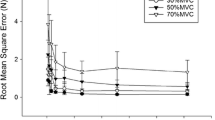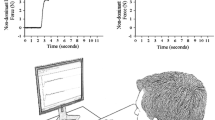Abstract
Variability in the force production is known to be influenced by intrinsic and extrinsic properties of the neuromuscular system. Here, we aim at investigating the role of visual feedback (presence or absence) on the neural control of muscle force during a broad range of isometric contractions of a hand’s muscle. Eight participants performed isometric abductions of the index finger in six submaximal contraction intensities (5–75% of the maximum voluntary contraction, MVC). In each trial, participants performed the task with and without visual feedback of the performed force. High-density surface electromyogram (EMG) was recorded from the first dorsal interosseous muscle. Spike trains of motor units were obtained after semi-automatic decomposition of surface EMG signals. The interspike intervals (ISI) of motor units and the effective neural drive to the muscle (smoothed cumulative spike train, sCST) were estimated. The mean value, standard deviation (SD) and coefficient of variation (CoV) were computed for the force, sCST, and ISI. No interaction between visual feedback and contraction conditions were found, neither an effect of visual feedback on the dependent variables. An increase in the contraction intensity was followed by an increase in the mean sCST and a decrease in the mean ISI. Contraction intensity increased the force SD and the sCST SD. CoV of force and sCST both only decreased from 5%MVC to 30%MVC. On the other hand, contraction intensity did not change ISI SD, but increased ISI CoV. These results revealed that visual feedback did not influence motor control strategies in a large range of force levels. Moreover, we provided evidence that force variability is mostly influenced by fluctuations in the activity of a population of motor units rather than the discharge properties of individual motor units.
Access this chapter
Tax calculation will be finalised at checkout
Purchases are for personal use only
Similar content being viewed by others
References
Slifkin AB, Newell KM (1999) Noise, information transmission, and force variability. J Exp Psychol 25:837–851
Watanabe RN, Magalhães FH, Elias LA et al (2013) Influences of premotoneuronal command statistics on the scaling of motor output variability during isometric plantar flexion. J Neurophysiol 110:2592–2606. https://doi.org/10.1152/jn.00073.2013
Dideriksen JL, Negro F, Enoka RM, Farina D (2012) Motor unit recruitment strategies and muscle properties determine the influence of synaptic noise on force steadiness. J Neurophysiol 107:3357–3369. https://doi.org/jn.00938.2011[pii]\n10.1152/jn.00938.2011
Jones KE, Hamilton AF, Wolpert DM (2002) Sources of signal-dependent noise during isometric force production. J Neurophysiol 88:1533–1544
Sosnoff JJ, Newell KM (2005) Intermittent visual information and the multiple time scales of visual motor control of continuous isometric force production. Percept Psychophys 67:335–344
Vaillancourt DE, Russell DM (2002) Temporal capacity of short-term visuomotor memory in continuous force production. Exp Brain Res 145:275–285. https://doi.org/10.1007/s00221-002-1081-1
Prodoehl J, Vaillancourt DE (2010) Effects of visual gain on force control at the elbow and ankle. Exp Brain Res 200:67–79. https://doi.org/10.1007/s00221-009-1966-3
Limonta E, Rampichini S, Cè E, Esposito F (2015) Effects of visual feedback absence on force control during isometric contraction. Eur J Appl Physiol 115:507–519. https://doi.org/10.1007/s00421-014-3036-1
Vaillancourt DE, Larsson L, Newell KM (2002) Time-dependent structure in the discharge rate of human motor units. Clin Neurophysiol 113:1325–1338. https://doi.org/S1388245702001670[pii]
Christou EA, Jakobi JM, Critchlow A et al (2004) The 1- to 2-Hz oscillations in muscle force are exacerbated by stress , especially in older adults. J Appl Physiol 97:225–235. https://doi.org/10.1152/japplphysiol.00066.2004
Baweja HS, Patel BK, Martinkewiz JD et al (2009) Removal of visual feedback alters muscle activity and reduces force variability during constant isometric contractions. Exp Brain Res 197:35–47. https://doi.org/10.1007/s00221-009-1883-5
Negro F, Muceli S, Castronovo AM et al (2016) Multi-channel intramuscular and surface EMG decomposition by convolutive blind source separation. J Neural Eng 13:026027. https://doi.org/10.1088/1741-2560/13/2/026027
Holobar A, Zazula D (2007) Multichannel blind source separation using convolution Kernel compensation. IEEE Trans Signal Process 55:4487–4496. https://doi.org/10.1109/TSP.2007.896108
Farina D, Negro F, Dideriksen JL (2014) The effective neural drive to muscles is the common synaptic input to motor neurons. J Physiol 592:3427–3441. https://doi.org/10.1113/jphysiol.2014.273581
Huddleston W, Keenan K, Ernest B (2013) Relations among visual strategies, force fluctuations, and attention during a force-matching task. Percept Mot Skills 117:775–800. https://doi.org/10.2466/22.24.PMS.117x29z6
Fox EJ, Baweja HS, Kim C et al (2013) Modulation of force below 1 Hz: age-associated differences and the effect of magnified visual feedback. PLoS ONE 8:e55970. https://doi.org/10.1371/journal.pone.0055970PONE-D-12-21601[pii]
Germer CM, Del Vecchio A, Negro F, et al (2020) Neurophysiological correlates of force control improvement induced by sinusoidal vibrotactile stimulation. J Neural Eng 17:1–14. https://doi.org/10.1088/1741-2552/ab5e08
Calvin WH, Stevens CF (1968) Synaptic noise and other sources of randomness in motoneuron interspike intervals. J Neurophysiol 31:574–587. https://doi.org/10.1152/jn.1968.31.4.574
Enoka RM, Duchateau J (2017) Rate coding and the control of muscle force. Cold Spring Harb Perspect Med a029702. https://doi.org/10.1101/cshperspect.a029702
Moritz CT, Barry BK, Pascoe MA, Enoka RM (2005) Discharge rate variability influences the variation in force fluctuations across the working range of a hand muscle. J Neurophysiol 93:2449–2459. https://doi.org/10.1152/jn.01122.2004
Negro F, Yavuz UŞ, Farina D (2016) The human motor neuron pools receive a dominant slow-varying common synaptic input. J Physiol 594:5491–5505. https://doi.org/10.1113/JP271748
Farina D, Negro F, Muceli S, Enoka RM (2016) Principles of motor unit physiology evolve with advances in technology. Physiology 31:83–94. https://doi.org/10.1152/physiol.00040.2015
Acknowledgements
CMG was the recipient of a Ph.D. scholarship from CAPES. She also received a Visiting Student Grant from PDSE/CAPES (proc. no. 88881.134842/2016-01). EPZ is the recipient of a PhD scholarship from FAPESP (proc. no. 2019/01508-4). LAE was funded by CNPq (proc. no. 312442/2017-3) and FAPESP (proc. no. 2017/22191-3).
Author information
Authors and Affiliations
Corresponding author
Editor information
Editors and Affiliations
Rights and permissions
Copyright information
© 2022 Springer Nature Switzerland AG
About this paper
Cite this paper
Germer, C.M., Zambalde, E.P., Elias, L.A. (2022). Influence of Visual Feedback Removal on the Neural Control Strategies During Isometric Force Production. In: Bastos-Filho, T.F., de Oliveira Caldeira, E.M., Frizera-Neto, A. (eds) XXVII Brazilian Congress on Biomedical Engineering. CBEB 2020. IFMBE Proceedings, vol 83. Springer, Cham. https://doi.org/10.1007/978-3-030-70601-2_319
Download citation
DOI: https://doi.org/10.1007/978-3-030-70601-2_319
Published:
Publisher Name: Springer, Cham
Print ISBN: 978-3-030-70600-5
Online ISBN: 978-3-030-70601-2
eBook Packages: EngineeringEngineering (R0)




